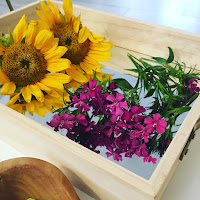What is a Provocation?
What is a Provocation?
A provocation can be an endless array of items, materials, visuals; any objects that provoke children to think, create, act, discuss and question their surrounding environment. Provocations are an open invitation for children to express themselves through the use of a diverse array of materials and intentional concepts. Some examples of provocations are; photographs of buildings next to blocks, loose parts such as rocks, leaves and sticks; these items are open ended materials that give space for children to create and build upon learning. Open ended materials are essential for setting up toddler provocations, they give children a diverse opportunity to explore their senses.
How can I bring this into the home environment?
I often time get asked on my page, “how can I get started on doing this with my child at home?” “What do I need to buy?” When thinking about provocations we must remember that it is an invitation, it must spark your child’s interest, it also should be intentional. What does this mean? The format in which the idea is presented must engage or provoke your child to explore, and begin research. Amazon shipment boxes, paper rolls, and straws make for amazing materials to use to build, sort, count, and create with. Place a picture of a building next to these materials and you now have a provocation. The materials should not be limiting, they should flexible enough that they can be anything the child chooses and this is the art of provocations. When we tune in to our children’s interest and needs it allows us to give children mindful invitations that provoke creativity and self expression.
Loose Parts Play
We use loose parts on a daily basis when setting up invitations for our students. What these essentially are “open-ended play materials and manipulatives that children can use in a variety of ways (Daly, L., & Beloglovsky, M. (2014).” Loose parts provide children with endless opportunities to build on play. Open ended materials make way for creativity to take place. Children are, counting, sorting, creating patterns and experiencing each objects shape, texture, color and size all the while creating their own concepts and ideas about each item. They are diverse and are not limiting, making way for children to engage in open ended play that do not interfere with a child’s creativity.
Resources
Daly, L., & Beloglovsky, M. (2014). Loose parts: Inspiring play in young children. St. Paul, MN: Redleaf Press.
Heydon, R., Crocker, W., & Zhang, Z. (2014). Novels, Nests and Other Provocations: Emergent Literacy Curriculum Production in a Childcare Centre. Journal Of Curriculum Studies, 46(1), 1-32.
Strong-Wilson, T., & Ellis, J. (2007). Children and Place: Reggio Emilia's Environment as Third teacher. Theory Into Practice, 46(1), 40-47.







Comments
Post a Comment